印度尼西亚简单介绍-英文
- 格式:pptx
- 大小:3.84 MB
- 文档页数:11
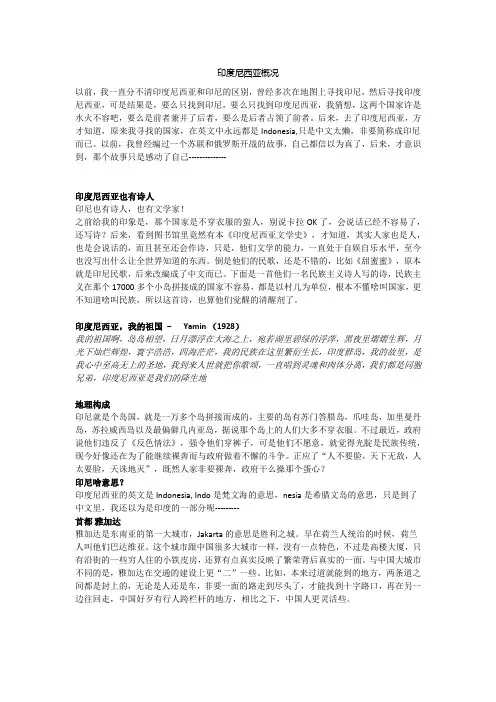
印度尼西亚概况以前,我一直分不清印度尼西亚和印尼的区别,曾经多次在地图上寻找印尼,然后寻找印度尼西亚,可是结果是,要么只找到印尼,要么只找到印度尼西亚,我猜想,这两个国家许是水火不容吧,要么是前者兼并了后者,要么是后者占领了前者。
后来,去了印度尼西亚,方才知道,原来我寻找的国家,在英文中永远都是Indonesia,只是中文太懒,非要简称成印尼而已。
以前,我曾经编过一个苏联和俄罗斯开战的故事,自己都信以为真了,后来,才意识到,那个故事只是感动了自己--------------印度尼西亚也有诗人印尼也有诗人,也有文学家!之前给我的印象是,那个国家是不穿衣服的蛮人,别说卡拉OK了,会说话已经不容易了,还写诗?后来,看到图书馆里竟然有本《印度尼西亚文学史》,才知道,其实人家也是人,也是会说话的,而且甚至还会作诗,只是,他们文学的能力,一直处于自娱自乐水平,至今也没写出什么让全世界知道的东西。
倒是他们的民歌,还是不错的,比如《甜蜜蜜》,原本就是印尼民歌,后来改编成了中文而已。
下面是一首他们一名民族主义诗人写的诗,民族主义在那个17000多个小岛拼接成的国家不容易,都是以村儿为单位,根本不懂啥叫国家,更不知道啥叫民族,所以这首诗,也算他们觉醒的清醒剂了。
印度尼西亚,我的祖国– Yamin (1928)我的祖国啊,岛岛相望,日月漂浮在大海之上,宛若湖里碧绿的浮萍,黑夜里熠熠生辉,月光下灿烂辉煌,寰宇浩浩,四海茫茫,我的民族在这里繁衍生长,印度群岛,我的故里,是我心中至高无上的圣地,我到来人世就把你歌颂,一直唱到灵魂和肉体分离,我们都是同胞兄弟,印度尼西亚是我们的降生地地理构成印尼就是个岛国,就是一万多个岛拼接而成的,主要的岛有苏门答腊岛,爪哇岛,加里曼丹岛,苏拉威西岛以及最偏僻几内亚岛,据说那个岛上的人们大多不穿衣服。
不过最近,政府说他们违反了《反色情法》,强令他们穿裤子,可是他们不愿意,就觉得光腚是民族传统,现今好像还在为了能继续裸奔而与政府做着不懈的斗争。
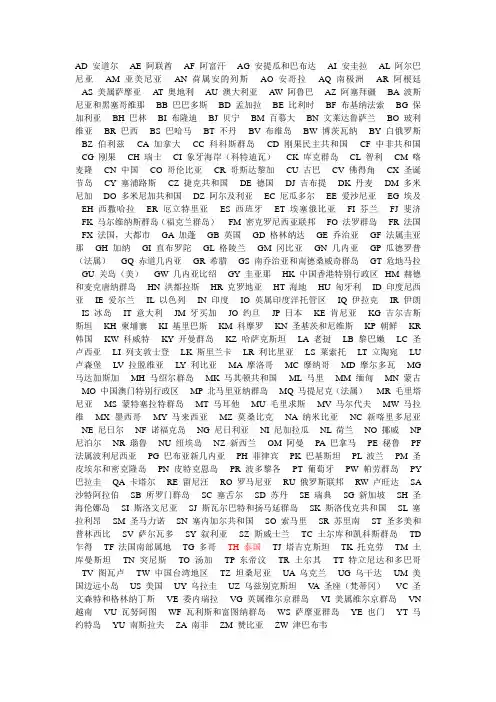
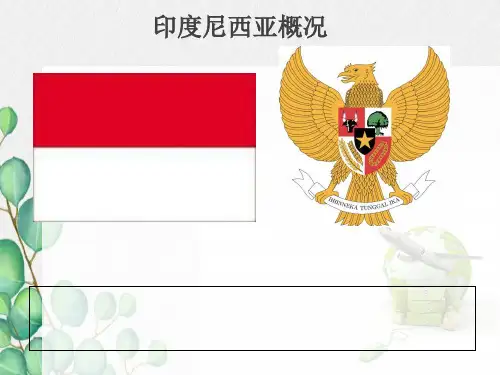
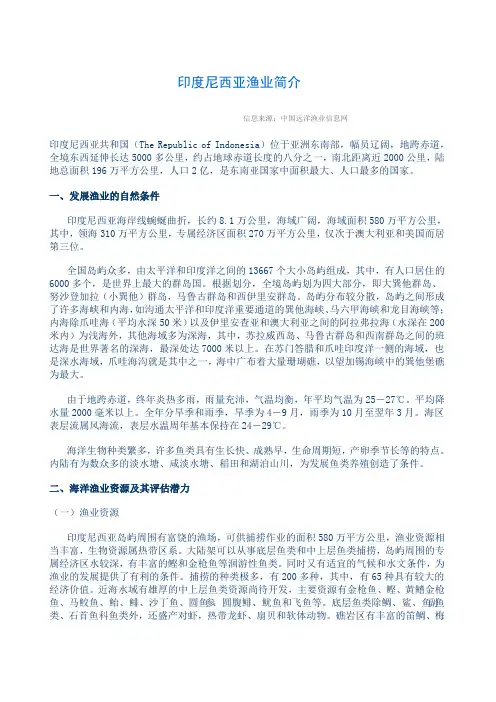
印度尼西亚渔业简介信息来源:中国远洋渔业信息网印度尼西亚共和国(The Republic of Indonesia)位于亚洲东南部,幅员辽阔,地跨赤道,全境东西延伸长达5000多公里,约占地球赤道长度的八分之一,南北距离近2000公里,陆地总面积196万平方公里,人口2亿,是东南亚国家中面积最大、人口最多的国家。
一、发展渔业的自然条件印度尼西亚海岸线蜿蜒曲折,长约8.1万公里,海域广阔,海域面积580万平方公里,其中,领海310万平方公里,专属经济区面积270万平方公里,仅次于澳大利亚和美国而居第三位。
全国岛屿众多,由太平洋和印度洋之间的13667个大小岛屿组成,其中,有人口居住的6000多个,是世界上最大的群岛国。
根据划分,全境岛屿划为四大部分,即大巽他群岛、努沙登加拉(小巽他)群岛,马鲁古群岛和西伊里安群岛。
岛屿分布较分散,岛屿之间形成了许多海峡和内海,如沟通太平洋和印度洋重要通道的巽他海峡、马六甲海峡和龙目海峡等;内海除爪哇海(平均水深50米)以及伊里安查亚和澳大利亚之间的阿拉弗拉海(水深在200米内)为浅海外,其他海域多为深海,其中,苏拉威西岛、马鲁古群岛和西南群岛之间的班达海是世界著名的深海,最深处达7000米以上。
在苏门答腊和爪哇印度洋一侧的海域,也是深水海域,爪哇海沟就是其中之一,海中广布着大量珊瑚礁,以望加锡海峡中的巽他堡礁为最大。
由于地跨赤道,终年炎热多雨,雨量充沛,气温均衡,年平均气温为25-27℃。
平均降水量2000毫米以上。
全年分旱季和雨季,旱季为4-9月,雨季为10月至翌年3月。
海区表层流属风海流,表层水温周年基本保持在24-29℃。
海洋生物种类繁多,许多鱼类具有生长快、成熟早,生命周期短,产卵季节长等的特点。
内陆有为数众多的淡水塘、咸淡水塘、稻田和湖泊山川,为发展鱼类养殖创造了条件。
二、海洋渔业资源及其评估潜力(一)渔业资源印度尼西亚岛屿周围有富饶的渔场,可供捕捞作业的面积580万平方公里,渔业资源相当丰富,生物资源属热带区系。
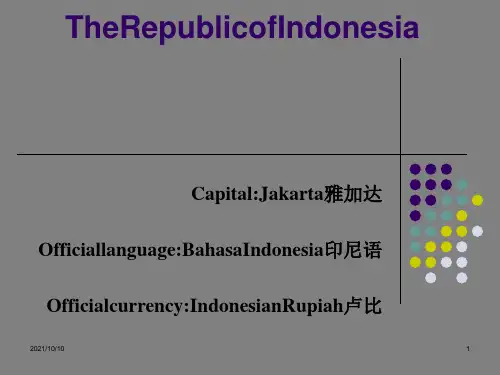
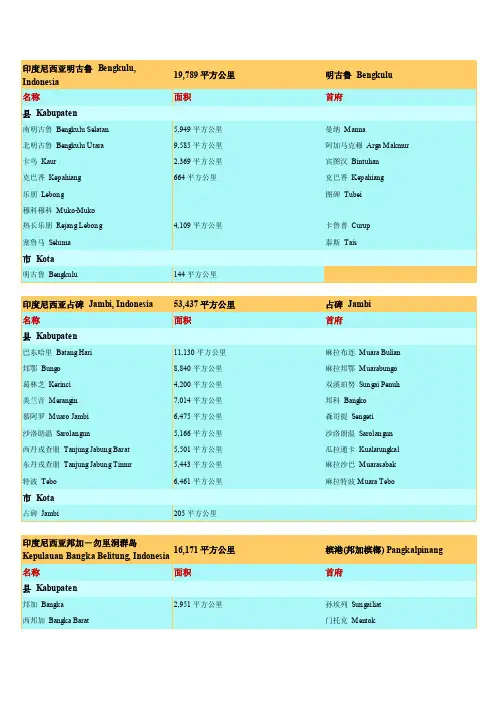
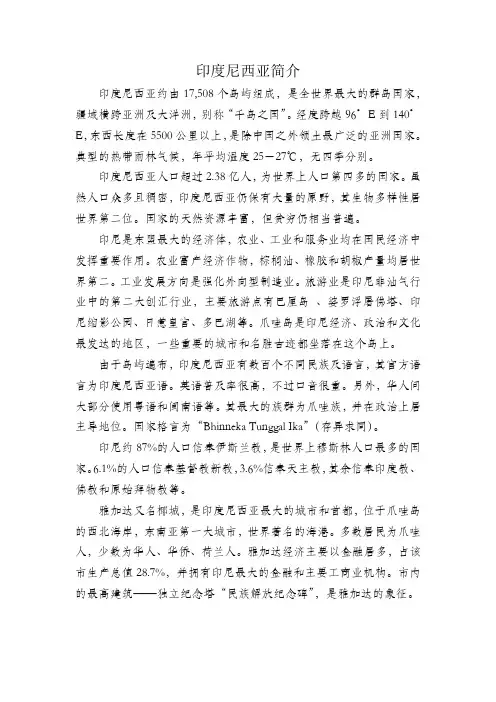
印度尼西亚简介印度尼西亚约由17,508个岛屿组成,是全世界最大的群岛国家,疆域横跨亚洲及大洋洲,别称“千岛之国”。
经度跨越96°E到140°E,东西长度在5500公里以上,是除中国之外领土最广泛的亚洲国家。
典型的热带雨林气候,年平均温度25-27℃,无四季分别。
印度尼西亚人口超过2.38亿人,为世界上人口第四多的国家。
虽然人口众多且稠密,印度尼西亚仍保有大量的原野,其生物多样性居世界第二位。
国家的天然资源丰富,但贫穷仍相当普遍。
印尼是东盟最大的经济体,农业、工业和服务业均在国民经济中发挥重要作用。
农业富产经济作物,棕榈油、橡胶和胡椒产量均居世界第二。
工业发展方向是强化外向型制造业。
旅游业是印尼非油气行业中的第二大创汇行业,主要旅游点有巴厘岛、婆罗浮屠佛塔、印尼缩影公园、日惹皇宫、多巴湖等。
爪哇岛是印尼经济、政治和文化最发达的地区,一些重要的城市和名胜古迹都坐落在这个岛上。
由于岛屿遍布,印度尼西亚有数百个不同民族及语言,其官方语言为印度尼西亚语。
英语普及率很高,不过口音很重。
另外,华人间大部分使用粤语和闽南语等。
其最大的族群为爪哇族,并在政治上居主导地位。
国家格言为“Bhinneka Tunggal Ika”(存异求同)。
印尼约87%的人口信奉伊斯兰教,是世界上穆斯林人口最多的国家。
6.1%的人口信奉基督教新教,3.6%信奉天主教,其余信奉印度教、佛教和原始拜物教等。
雅加达又名椰城,是印度尼西亚最大的城市和首都,位于爪哇岛的西北海岸,东南亚第一大城市,世界著名的海港。
多数居民为爪哇人,少数为华人、华侨、荷兰人。
雅加达经济主要以金融居多,占该市生产总值28.7%,并拥有印尼最大的金融和主要工商业机构。
市内的最高建筑——独立纪念塔“民族解放纪念碑”,是雅加达的象征。
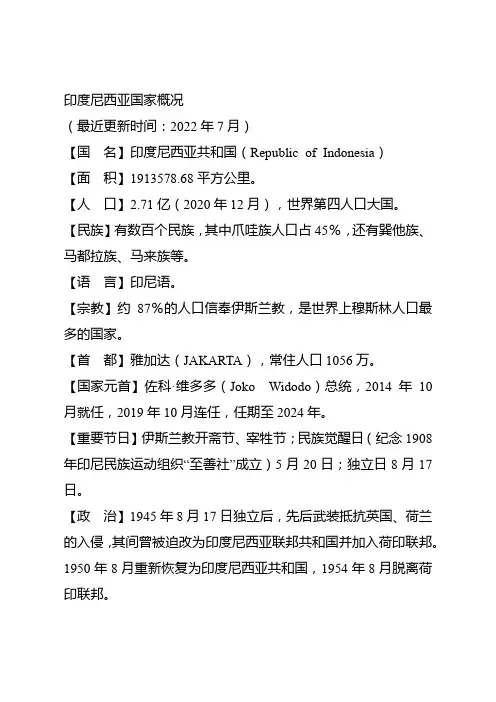
印度尼西亚国家概况(最近更新时间:2022年7月)【国名】印度尼西亚共和国(Republic of Indonesia)【面积】1913578.68平方公里。
【人口】2.71亿(2020年12月),世界第四人口大国。
【民族】有数百个民族,其中爪哇族人口占45%,还有巽他族、马都拉族、马来族等。
【语言】印尼语。
【宗教】约87%的人口信奉伊斯兰教,是世界上穆斯林人口最多的国家。
【首都】雅加达(JAKARTA),常住人口1056万。
【国家元首】佐科·维多多(Joko Widodo)总统,2014年10月就任,2019年10月连任,任期至2024年。
【重要节日】伊斯兰教开斋节、宰牲节;民族觉醒日(纪念1908年印尼民族运动组织“至善社”成立)5月20日;独立日8月17日。
【政治】1945年8月17日独立后,先后武装抵抗英国、荷兰的入侵,其间曾被迫改为印度尼西亚联邦共和国并加入荷印联邦。
1950年8月重新恢复为印度尼西亚共和国,1954年8月脱离荷印联邦。
1997年亚洲金融危机对印尼造成全面冲击,引起局势动荡。
1998年5月,执政长达32年的苏哈托(Suharto)总统辞职,副总统哈比比(B.J.Habibie)接任总统。
1999年10月,印尼人民协商会议(简称“人协”)选举瓦希德(Abdurrahman Wahid)为总统,梅加瓦蒂(Megawati Sukarnoputri)为副总统。
2001年7月23日,人协特别会议以渎职罪罢免瓦希德总统职务,梅加瓦蒂接任总统,哈姆扎·哈兹任(Hamzah Haz)副总统。
2004年7月,印尼举行历史上首次总统直选,原政治安全统筹部长苏希洛(Susilo Bambang Yudhoyono)和人民福利统筹部长尤素夫·卡拉(Muhammad Jusuf Kalla)通过两轮直选胜出。
2009年7月,印尼举行第二次总统直选,苏希洛和原央行行长布迪约诺(Boediono)竞选搭档首轮胜出。
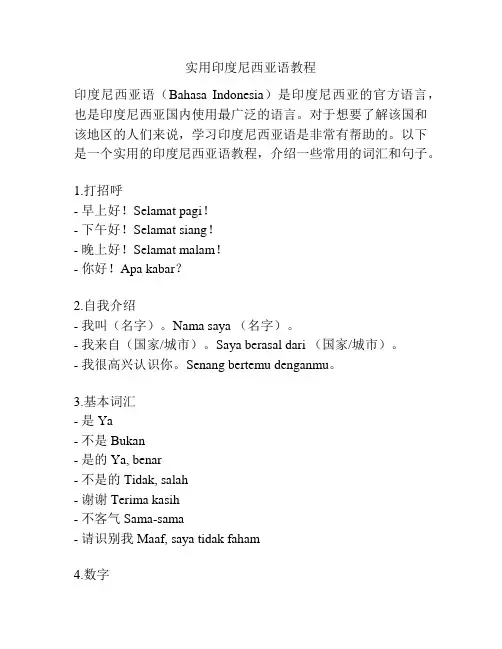
实用印度尼西亚语教程印度尼西亚语(Bahasa Indonesia)是印度尼西亚的官方语言,也是印度尼西亚国内使用最广泛的语言。
对于想要了解该国和该地区的人们来说,学习印度尼西亚语是非常有帮助的。
以下是一个实用的印度尼西亚语教程,介绍一些常用的词汇和句子。
1.打招呼- 早上好!Selamat pagi!- 下午好!Selamat siang!- 晚上好!Selamat malam!- 你好!Apa kabar?2.自我介绍- 我叫(名字)。
Nama saya (名字)。
- 我来自(国家/城市)。
Saya berasal dari (国家/城市)。
- 我很高兴认识你。
Senang bertemu denganmu。
3.基本词汇- 是 Ya- 不是 Bukan- 是的 Ya, benar- 不是的 Tidak, salah- 谢谢 Terima kasih- 不客气 Sama-sama- 请识别我 Maaf, saya tidak faham4.数字- 一 Satu- 二 Dua- 三 Tiga- 四 Empat- 五 Lima- 六 Enam- 七 Tujuh- 八 Delapan- 九 Sembilan- 十 Sepuluh5.常见问候- 你好吗?Apa kabar?- 我很好。
Saya baik-baik saja。
- 你叫什么名字?Siapa nama kamu?- 我叫(名字)。
Nama saya (名字)。
- 请问洗手间在哪里?Maaf, di mana kamar mandi?6.日常用语- 请帮我。
Tolong bantu saya。
- 我迷路了。
Saya tersesat。
- 多少钱?Berapa harganya?- 我不明白。
Saya tidak mengerti。
- 请再说一遍。
Tolong diulang。
7.常用短语- 什么时候?Kapan?- 如何去(地点)?Bagaimana pergi ke (地点)?- 那里有(地点)吗?Apakah ada (地点) di sana?- 我想要一杯咖啡。

More than 1 billion people live in India, a country in southern Asia. Only China has more people. The people of India speak more than 100 different languages.Facts About IndiaOfficial name Republic of IndiaCapital New DelhiPopulation 1,150,000,000 peopleRank among countries inpopulation2ndMajor cities Kolkata (Calcutta), Delhi, Mumbai (Bombay)Area 1,220,000 square miles3,170,000 square kilometersRank among countries in area 7thHighest point Kanchenjunga28,209 feet/8,598 metersCurrency Indian rupeeCITIES AND VILLAGESKolkata (also spelled Calcutta) is India’s largest city. Mumbai (also called Bombay) is the country’s most populated urban area. They rank among the world’s largest cities, too. New Delhi is the capital of India.More than 16 million people live in or near the port city of Mumbai. Mumbai is a center of trade and the center of India’s movie business. India makes about 800 movies a year, more than any other country in the world.In spite of its large cities, India is primarily a country of villages. Most of India’s people make their living by farming. Many of them are extremely poor.More and more people are moving from rural areas of India to cities. They hope to find better-paying jobs in the cities. India’s cities ha ve become very crowded as a result.A SUBCONTINENTIndia is shaped like a triangle. It juts out from the bottom of Asia into the Indian Ocean. India is sometimes called a subcontinent. Is thisbecause India is big? Not really. Six countries—including Russia, Canada, and the United States—are bigger.India is a subcontinent because it is cut off from the rest of Asia. Mountains, jungles, and the Indian Ocean form barriers that make India a world apart—a subcontinent.India’s neighbors Pakistan and Bangladesh also form part of the Indian subcontinent. These lands were once part of India.A LAND OF CONTRASTSThe Indian subcontinent offers striking contrasts. The Himalayas, the world’s highest mountains, extend across northern India. Towns lie on the lower slopes, but few people live high in the mountains.South of the mountains stretch broad plains. Two great rivers, the Ganges and the Brahmaputra, flow through the plains. Tea grows on plantations to the east. The huge Thar Desert lies to the west.A vast plateau lies south of the plains. Much of this region is rocky. The climate of the plateau is extremely hot. Every summer, winds called monsoons drop heavy rain on India.JUNGLES AND WILDLIFEThe English language borrowed the word jungle from Hindi, the languag e spoken by most Indians. India’s jungles are home to many fascinating animals. Tigers, panthers, lions, cheetahs, snow leopards, monkeys, and elephants are all found in India. So is the poisonous cobra snake. India has many national parks and wildlife preserves where its animals can be seen.TAJ MAHALThe Taj Mahal in Agra, India, is considered one of the most beautiful buildings in the world. An emperor built it after the death of his young wife. She died in 1631. Her tomb is inside.The Taj Mahal is covered in white marble and set in a garden with pools of water. The garden represents paradise. The building is decorated with beautiful carvings and colored stones. Its color appears to change throughout the day as the sun moves across the sky.RELIGION IN INDIAHinduism and Buddhism, two of the world’s major religions, were born in India. So were the Jain and Sikh religions. Most of India’s people are Hindus. Muslims—followers of Islam—are second in number.Hindus worship in the many beautiful temples they have built in India. They also worship at home. Hindus worship all life. They do not kill animals, and they do not eat meat.Muslims also have built many beautiful buildings, including the Taj Mahal. Hindus and Muslims have not always gotten along. Muslim invaders brought Islam to India. For centuries, Muslims ruled a largely Hindu country.A BRITISH COLONYDuring the 1700s, Britain gained control of India. Many Indians began speaking English. British sports, such as cricket and badminton, became popular. But many British efforts to change Indian customs and traditions were far less popular.MAHATMA GANDHIMohandas K. Gandhi was a Hindu who led India to independence from Britain. Gandhi’s followers called him Mahatma, which means “great soul.”Gandhi taught people to work for independence without using violence. Thanks to his efforts, India gained its independence in 1947. Gandhi’s policy of nonviolence influenced many other people. In the United States, Martin Luther King, Jr., used Gandhi’s idea of nonviol ent protests to gain civil rights for black Americans.AFTER INDEPENDENCEWhen India gained its independence, it split apart. The parts of India that were primarily Muslim became the country of Pakistan. Pakistan was made up of two parts, one to the east of India and the other to the west. In 1971, East Pakistan became a separate country called Bangladesh.。

介绍印度尼西亚的英语作文English:Indonesia, the largest archipelago in the world, is a diverse and culturally rich country located in Southeast Asia. With over 17,000 islands, Indonesia is known for its stunning natural landscapes, including tropical rainforests, beautiful beaches, and active volcanoes. The country is home to a population of over 270 million people, making it the fourth most populous country in the world. Jakarta, the capital city, is a bustling metropolis that reflects Indonesia's rapid economic growth and development. The country's cultural diversity is evident in its various ethnic groups, languages, and religions. Bahasa Indonesia is the official language, although English is widely spoken, especially in urban areas and tourist destinations. Indonesia's history is a tapestry of different cultures, from the powerful maritime empires to Dutch colonization, and it gained independence in 1945. Indonesian cuisine is renowned for its rich flavors and variety, with dishes like nasi goreng, rendang, and sate being popular worldwide. The country is also known for its vibrant arts scene, including traditional dance, music, and puppetry. Indonesia's economy is one of the largest in Southeast Asia, withagriculture, manufacturing, and tourism being the main drivers. Despite its economic progress, the country faces challenges such as poverty, corruption, and environmental issues. However, Indonesia remains a land of opportunity and beauty, attracting visitors from around the globe with its warm hospitality, breathtaking scenery, and diverse cultural experiences.Translated content:印度尼西亚是世界上最大的群岛国家,位于东南亚,是一个多元化和文化丰富的国家。
介绍印度尼西亚的英语作文Indonesia, a nation of over 17,000 islands, is a vibrant tapestry of cultures, languages, and natural beauty. As the largest archipelago in the world, it stretches across the equator from the Indian Ocean to the Pacific, offering a unique blend of experiences that attract travelers from all corners of the globe.Geography and NatureThe Indonesian landscape is as diverse as its people.From the lush rainforests of Sumatra and the volcanic peaksof Java to the coral reefs of Bali and the savannas of Flores, the country is a haven for nature lovers. The iconic Komodo National Park is home to the world's largest lizard, the Komodo dragon, while the orangutans of Borneo are a testament to the region's rich biodiversity.Culture and TraditionsIndonesia's cultural mosaic is a result of centuries of trade, colonization, and migration. The influence of Hinduism, Buddhism, and Islam can be seen in the country's art, architecture, and festivals. Traditional dances like the Balinese Kecak and the Javanese Wayang Kulit shadow puppetry are deeply rooted in the nation's heritage, providing awindow into the past.Economy and DevelopmentAs the world's 16th largest economy, Indonesia is a significant player in the global market. Rich in natural resources such as coal, natural gas, and palm oil, the country is also diversifying its economy through tourism and manufacturing. The capital, Jakarta, is a bustling metropolis that exemplifies the nation's rapid development and urbanization.Cuisine and FoodIndonesian cuisine is a delightful fusion of flavors, reflecting the country's multicultural heritage. Rice is a staple, often accompanied by a variety of dishes such as nasi goreng (fried rice), gado-gado (vegetable salad with peanut sauce), and rendang (spicy meat curry). The use of spiceslike chili, turmeric, and lemongrass gives Indonesian foodits distinctive taste.Tourism and AttractionsTourism is a vital part of Indonesia's economy, with destinations like Bali, Jakarta, and Yogyakarta drawing millions of visitors annually. Beyond the beaches, Indonesia offers historical sites such as the ancient Borobudur Temple and the royal tombs of Sukuh and Pawon. Adventure seekers can explore the volcanic landscapes of Mount Bromo and Mount Rinjani, while scuba divers can marvel at the underwater world in Raja Ampat.Challenges and OpportunitiesDespite its many attractions, Indonesia faces challenges such as environmental degradation, natural disasters, and economic inequality. However, the country's resilience and commitment to sustainable development offer hope for a prosperous future. Initiatives to protect endangered species and to preserve the environment are gaining momentum, promising a harmonious balance between progress and conservation.In conclusion, Indonesia is a country of extraordinary contrasts and compelling attractions. Its natural wonders, cultural depth, and economic potential make it a fascinating destination for exploration and investment. As it continues to grow and evolve, Indonesia stands as a beacon of diversity and resilience in Southeast Asia.。
表示国籍的单词i开头全文共四篇示例,供读者参考第一篇示例:国籍是一个人在法律上所属的国家或民族。
在国际交往中,表示国籍的单词通常以英语字母开头。
今天我们来看一下以字母“i”开头的表示国籍的单词。
1. Indian(印度)印度是一个多元文化的国家,拥有悠久的历史和灿烂的文化。
印度人复杂多样,有着不同的宗教信仰、语言和习俗。
印度的美食、服饰、音乐、舞蹈等都深受世界各国喜爱。
印度人以聪明、勤奋和友好著称。
2. Indonesian(印度尼西亚)印度尼西亚是一个东南亚国家,由数千个岛屿组成。
印度尼西亚境内拥有令人叹为观止的自然景观和文化遗产,吸引了众多游客。
印度尼西亚人民热情好客,热爱自己的国家和文化。
3. Irish(爱尔兰)爱尔兰是欧洲的一个岛国,充满了神秘和传奇色彩。
爱尔兰是一个有着浓厚文化底蕴和悠久历史的国家,盛产文学、音乐、舞蹈等艺术作品。
爱尔兰人热爱生活,喜欢交际和欢乐。
4. Israeli(以色列)以色列是位于中东的一个国家,被誉为“犹太人之家”。
以色列是一个充满活力和创意的国家,拥有发达的科技产业和文化艺术。
以色列人民对传统和历史有着深厚的情感,注重家庭和社区。
5. Italian(意大利)意大利是一个美食之国,以其丰富多样的美食和艺术文化而闻名于世。
意大利人热情奔放,热爱生活,喜欢交际和热闹。
意大利音乐、时装、建筑等领域都在国际上具有重要影响力。
6. Iraqi(伊拉克)伊拉克是一个位于中东的国家,拥有悠久的历史和文化传统。
伊拉克人民多数信仰伊斯兰教,注重家庭和宗族关系。
尽管伊拉克经历了多年的战乱和动荡,但人民仍然坚强勇敢,努力重建家园。
7. Icelandic(冰岛)冰岛是一个欧洲北部寒冷的岛国,拥有独特的自然风光和文化传统。
冰岛人民热爱自然,尊重环境,注重健康和生态平衡。
冰岛是一个安静祥和的国家,适合度假休闲。
8. Iranian(伊朗)伊朗是一个西亚国家,有着悠久的历史和文化。
伊朗人民多数信奉伊斯兰教,注重家庭、信仰和传统。
一分钟认识印度尼西亚简称:印尼全称:印度...
一分钟认识印度尼西亚
简称:印尼
全称:印度尼西亚共和国
首都:雅加达
人口:2.62亿人(世界第四人口大国)
GDP : 1.12万亿美元
建国日:1950年8月
国歌:《伟大的印度尼西亚》
陆地面积:191万平方千米
印度尼西亚是全世界最大的群岛国家,疆域横跨亚洲及大洋洲,约由17508个岛屿组成。
与巴布亚新几内亚、东帝汶、马来西亚交界,与泰国、新加坡、菲律宾、澳大利亚等国隔海相望。
由于地理位置的原因也造成了多火山多地震的国家。
印度尼西亚尼是盟创立国之一,1967年,其与马来西亚、菲律宾、新加坡和泰国成立了“东南亚国家联盟”,即东盟;印尼也是东南亚最有影响力的经济体。